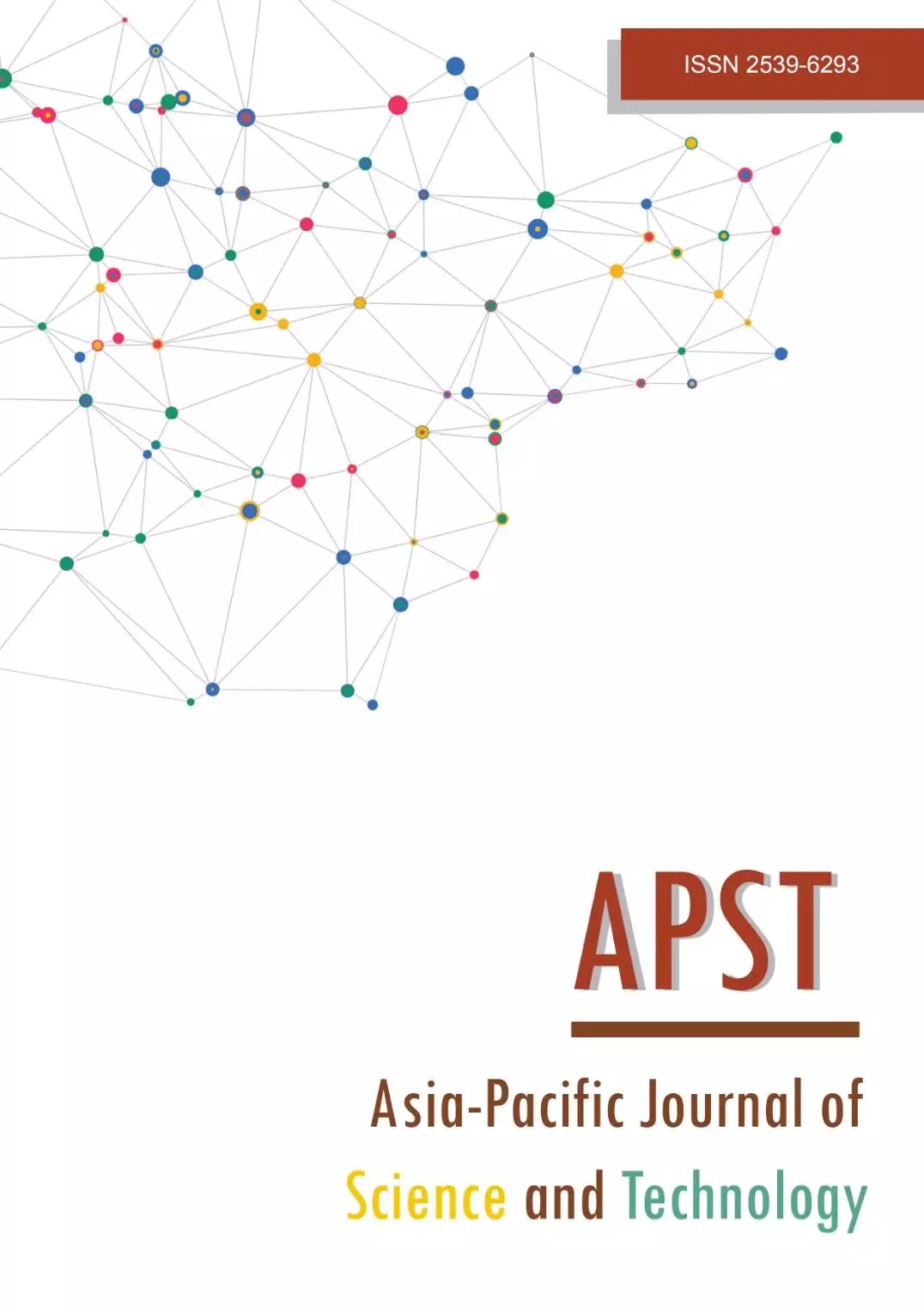A deep learning model for air leak detection from a pipe fitting using an accelerometer
Main Article Content
Abstract
Gas leaks from fittings of a pneumatic pipe system result in the breakdown or failure of the system. It’s about half of the losses of output from production lines in the manufacturing sector. Deep learning (DL) methods can be used to detect gas leakage of the pneumatic pipe system. We propose the DL model for the detection of air leaks from pneumatic pipe system fittings using an accelerometer sensor system. We trained four models with four machine learning (ML) techniques with the data generated from our experimental pneumatic pipe. We augmented the collected data and used it to train all four models again and were able to mimic the natural behavior of the actual line and thereby augment the collected data, which was used in an enhanced training and testing process to create a better model. One of the trained models in which the augmented data was applied yielded the highly accurate result of 99.2%. Our main contribution to the field is our method of evaluating the accuracy of the model and the simple algorithm that one may use as a basis for building applications based on the model, together with the model's evaluation results. Our findings and contribution provide well-tested information to engineers and companies to avoid breakdowns in pneumatic pipe systems caused by air leaks. We claim that these contributions are new, and to the best of our knowledge have not previously been reported in the literature, thus are relevant and important contributions to the field.
Article Details

This work is licensed under a Creative Commons Attribution-NonCommercial-NoDerivatives 4.0 International License.
References
Guenther T, Kroll A. Automated detection of compressed air leaks using a scanning ultrasonic sensor system. IEEE Sensors Applications Symposium (SAS); 2016 Apr 20-22; Catanai, Italy. New Jersey: IEEE Xplore; 2016. p. 1-6.
Zhang S, Asakura T, Hayashi S. Gas leakage fault detection of pneumatic pipe system using neural networks. JSME Int J. 2004;47(2):568-572.
Scussel O, Brennan MJ, Almeida FCL, Muggleton JM, Rustighi E, Joseph PF. Estimating the spectrum of leak noise in buried plastic water distribution pipes using acoustic or vibration measurements remote from the leak. Mech Syst Signal Process. 2021;147:107059.
Vafaei N, Ribeiro R, Matos CL. Fuzzy early warning systems for condition based maintenance. Comput Ind Eng. 2019;128:736-746.
Ismail MI, Dziyauddin RA, Salleh ANA, Sukki MF, Aini Bani N, Mohd Izhar MA, et al. A review of vibration detection methods using accelerometer sensors for water pipeline leakage. IEEE Access. 2019;7:51965-51981.
Rashid A, Abduljabbar H, Alhayani B. Coronavirus disease (COVID-19) cases analysis using machine-learning applications. Appl Nanosci. 2023;13(3):2013-2025.
Carvalho TP, Soares FA, Vita R, Francisco RP, Basto JP, Alcala SG. A systematic literature review of machine learning methods applied to predictive maintenance. Comput Ind Eng. 2019;137:106024.
Yang Q, Guo B, Lin M. Differential pressure prediction in air leak detection using RBF neural network. Conference on Artificial Intelligence and Computational Intelligence; 2010 Oct 23-24; Sanya, China. New Jersey; IEEE Xplore; 2010. p. 211-213.
Kavlakoglu E. AI vs. Machine learning vs. deep learning vs. neural networks: what’s the difference?, https://www.ibm.com/cloud/blog/ai-vs-machine-learning-vs-deep-learning-vs-neural-networks [accessed 27 November 2021].
Ran Y, Zhou X, Lin P, Wen Y, Deng R. A survey of predictive maintenance: systems, purposes and approaches. arXiv EESS 2019; arXiv:1912.07383. doi.org/10.48550/arXiv.1912.07383.
Myles AJ, Feudale RN, Liu Y, Nathaniel A, Woody N, Brown S. An introduction to decision tree modeling. J Chemometrics. 2004;18:275-285.
LeCun Y, Bengio Y, Hinton G. Deep learning. Nature. 2015;521:436-444.
Valueva MV, Nagornov NN, Lyakhov PA, Valuev GV, Chervyakov NI. Application of the residue number system to reduce hardware costs of the convolutional neural network implementation. Math Comput Simul. 2020;177:232-243.
Fawaz IH, Forestier G, Weber J, Idoumghar L, Muller PA. Transfer learning for time series classification. IEEE International Conference on Big Data (Big Data); 2018 Dec 10-13; Seattle, United States. New Jersey: IEEE Xplore; 2019. p. 1367-1376.
Kiranyaz S, Avci O, Abdeljaber O, Ince T, Gabbouj M, Inman DJ. 1D convolutional neural networks and applications: a survey. Mech Syst Signal Process. 2021;151:107398.
Qin H, Xu K, Ren L. Rolling bearings fault diagnosis via 1d convolution networks. IEEE International Conference on Signal and Image Processing (ICSIP); 2019 Jul 19-21; Wuxi, China. New Jersey: IEEE Xplore; 2019. p. 617-621.
Sammut C, Webb GI. Encyclopedia of machine learning. 1st ed. New York: Springer Publishing; 2011.
Deng X, Liu Q, Deng Y, Mahadevan S. An improved method to construct basic probability assignment based on the confusion matrix for classification problem. Inf Sci. 2016;340-341:250-261.
Barandas M, Folgado D, Fernandes L, Santos S, Abreu M, Bota P, et al. TSFEL: Time series feature extraction library. SoftwareX. 2020;11:100456.
Kramer O. Scikit-learn. In: Kramer O, editor. Machine learning for evolution strategies. 1st ed. New York: Springer Charm; 2016, p. 45-53.
Ketkar N. Introduction to Keras. In: Chollet F, editor. Deep learning with Python. 1st ed. New York: Manning Publications; 2017, p. 97-111.
Sklearn. Free software machine learning in Python, https://scikit-learn.org [accessed 27 November 2021].
Brownlee J. How to calculate feature importance with Python, https://machinelearningmastery.com/calcu
late-feature-importance-with-python/ [accessed 27 November 2021].
Sklearn. Feature importances with a forest of trees, https://scikit-learn.org/stable/autoexamp les/ensemble/plot_forest_importances.html [accessed 27 November 2021].
Thabet M, Sanders D, Becerra V, Tewkesbury G, Haddad M, Barker T. Intelligent energy management of compressed air systems. IEEE International Conference on Intelligent Systems (IS); 2020 Aug 28-30; Varna, Bulgaria. New Jersey: IEEE Xplore; 2020. p. 153-158.


